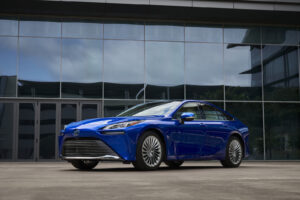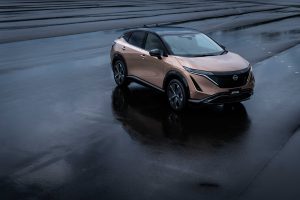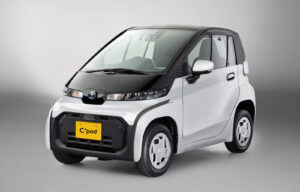
GM’s Chief Sustainability Officer Dane Parker outline the company’s plans for not just transforming vehicles, but also the facilities where they’re designed and built.
The auto industry is undergoing the most “significant transition” it has seen in a century, and General Motors doesn’t intend to be left behind, the automaker’s chief sustainability officer said during a media briefing ahead of the release of GM’s annual sustainability report today.
If anything, the company is accelerating plans to switch entirely to battery-electric vehicles, even as it continues to develop hydrogen fuel-cell technology. GM also is working to switch to zero-emissions sources to power its plants, said CSO Dane Parker.
“We’re very confident that … in a five- to 10-year timeframe, we’ll see a very different transportation industry,” Parker told reporters.
(GM reveals flexible EV platform, new “Ultium” batteries.)

The Chevrolet Bolt EV will be one of about 20 GM battery-cars on the market by 2023, the automaker says.
GM was one of the first carmakers to push seriously into electrification, its Chevrolet Volt becoming the first mass-market plug-in hybrid a decade ago. It is now focusing on pure battery-electric vehicles and Parker confirmed it will have “at least 20 by 2023,” about half of them having been previewed last March at one of two GM battery-car events in suburban Detroit.
That includes two versions of the all-electric GMC Hummer, a pickup and an SUV, coming next year, as well as an extended-length iteration of GM’s current long-range hatchback, the Chevy Bolt.
All told, the carmaker has now committed to “allocate more than $20 billion of capital and engineering resources to its electric and autonomous vehicle programs between 2020 and 2025,” according to a summary of GM’s 10th annual sustainability report.
As vehicle development work continues, the Detroit carmaker is also pushing ahead on construction of a new battery plant in Ohio that is part of its partnership with Korea’s LG Chem. The new Ultium batteries set to be produced there will have a higher energy density – meaning more power in a smaller pack – and lower cost, GM President Mark Reuss predicting the company could reach parity on the cost of an electric vehicle compared to a gas model by mid-decade.

GM just eliminated the Sonic so its Orion (MI) plant that now builds just the Bolt will get a second electric vehicle.
The Ultium batteries have other advantages, said Parker, noting they will use significant less cobalt than current lithium-ion cells. They will also be easier to replace than current batteries and will eventually be easier to recycle. One of the key goals outlined in the GM report is to either recycle or find post-life uses for Ultium batteries. There are numerous possibilities, Parker noted. That could include being used in grid backup systems that could help prevent blackouts and power surges.
“The vision we have for an all-electric future will result in the longer-term elimination of internal combustion engines,” said Parker, though he declined to lay out a specific timetable. One reason is that this could vary by market. Different countries, he added, “will have different timelines for us to get there.”
(GM transforming Poletown plant in primary EV production site.)
Europe, for example, is pushing aggressively to replace gas and diesel power, backing that with incentives and investments in a charging infrastructure. China is moving rapidly in that direction as well. But, at least under the Trump administration, the U.S. is moving more cautiously.

GM teased the GMC Hummer during the Super Bowl and has since confirmed there will be both pickup and SUV versions.
GM isn’t just looking at battery power. The automaker was an early proponent of hydrogen fuel-cell technology and two years ago launched a joint venture with Honda. The Japanese automaker, said Parker, is focusing on automotive applications for fuel cells. GM, on the other hand, is emphasizing stationary applications, such as back-up power for cellphone towers.
“When we look at what is the faster way to deployment (of zero-emissions vehicles), it’s battery electric,” Parker explained, noting that the big challenge for hydrogen is the lack of a refueling infrastructure. That’s one reason that automakers currently marketing fuel cell vehicles, such as the Honda Clarion, are largely limited to parts of California, where most U.S. hydrogen stations are located.
Parker did not rule out the possibility that GM could eventually use some of the fuel-cell stacks it plans to build at a new plant in Michigan for transportation applications. But “we do not plan to produce” those vehicles. Instead, he explained, “we are certainly ready to explore options to partner” with another company that might want to produce hydrogen trucks using GM stacks.

General Motors’ Arlington, Texas plant is using 100% wind-generated power.
Parker hinted the automaker will have news to make about its hydrogen program “in the coming months.”
GM has aggressively expanded its approach to clean technologies since Mary Barra became CEO in January 2014. That is not limited to its vehicles. The automaker also wants to switch from conventional to sustainable power sources for its factories. The goal was to get to 100% renewable sources by 2050, said Parker, but that recently was pushed ahead to 2050 worldwide. And the pace is going even more quickly in the U.S.
The big truck plant in Arlington, Texas is already using 100% wind-generated power and GM recently signed up with the TVA to deliver 100 megawatts of solar energy by 2023. That same year, it expects about 800 mW of clean electricity for its Michigan plants, with a goal of 60% renewable power for all operations in the U.S.
(GM increases uses of renewable energy.)
Noting the increased availability of green power, even as prices fall, Parker said “that gives us great confidence in (reaching) that number.”
html div#gJSomKNtPm div#gJSomKNtPm_inpost.columbine-container { background: #fff; border: 3px solid #91a6bf; -webkit-border-radius: 5px; -moz-border-radius: 5px; border-radius: 5px; max-width: 100%; margin: 10px auto; text-align: center; width: 100%; padding: 20px 30px; color: #555; -webkit-box-sizing: border-box; -moz-box-sizing: border-box; box-sizing: border-box; } html div#gJSomKNtPm div#gJSomKNtPm_inpost.columbine-container div.columbine-miniText { font-size: 1em; line-height: 28px; text-transform: uppercase; color: #54C3A5; font-weight: bold; display:none; } html div#gJSomKNtPm div#gJSomKNtPm_inpost.columbine-container div.columbine-heading { font-weight: bold; line-height: 1.5; } html div#gJSomKNtPm div#gJSomKNtPm_inpost.columbine-container div.columbine-caption { margin-top: 12px; font-style: italic; font-size: 18px; line-height: 28px; } html div#gJSomKNtPm div#gJSomKNtPm_inpost.columbine-container .columbine-form { overflow: hidden; margin-top: 20px; } html div#gJSomKNtPm div#gJSomKNtPm_inpost.columbine-container div.columbine-three-col1 { float: left; width: 33.333%; } html div#gJSomKNtPm div#gJSomKNtPm_inpost.columbine-container div.columbine-three-col2 { float: left; width: 33.333%; } html div#gJSomKNtPm div#gJSomKNtPm_inpost.columbine-container div.columbine-three-col3 { float: left; width: 33.333%; } html div#gJSomKNtPm div#gJSomKNtPm_inpost.columbine-container div.columbine-two-col1 { float: left; width: 66.333%; } html div#gJSomKNtPm div#gJSomKNtPm_inpost.columbine-container div.columbine-two-col2 { float: right; width: 33.333%; } html div#gJSomKNtPm div#gJSomKNtPm_inpost.columbine-container input.columbine-input, html div#gJSomKNtPm div#gJSomKNtPm_inpost.columbine-container input.mo-optin-form-custom-field.text-field, html div#gJSomKNtPm div#gJSomKNtPm_inpost.columbine-container textarea.mo-optin-form-custom-field.textarea-field { background-color: #ffffff; width: 100%; display: block; -webkit-box-sizing: border-box; -moz-box-sizing: border-box; box-sizing: border-box; -webkit-appearance: none; -webkit-border-radius: 0; -moz-border-radius: 0; border-radius: 0; padding: 11px 17px; font-size: 16px; line-height: 16px; text-align: left; border: 1px solid #ccc; color: #555; outline: none; margin: 0; } html div#gJSomKNtPm div#gJSomKNtPm_inpost.columbine-container input.columbine-submit, html div#gJSomKNtPm div#gJSomKNtPm_inpost.columbine-container input[type="submit"].mo-optin-form-cta-button { display: block; -webkit-box-sizing: border-box; -moz-box-sizing: border-box; box-sizing: border-box; -webkit-appearance: none; border: 0; background: #54C3A5; padding: 13px 18px; font-size: 16px; line-height: 16px; text-align: center; color: #fff; outline: none; cursor: pointer; font-weight: 600; width: 100%; margin: 0; border-radius: 0; } html div#gJSomKNtPm div#gJSomKNtPm_inpost.columbine-container div.columbine-note { margin-top: 10px; line-height: normal; } html div#gJSomKNtPm div#gJSomKNtPm_inpost.columbine-container div.mo-optin-error { display: none; background: #FF0000; color: white; text-align: center; padding: .2em; margin: 0; width: 100%; font-size: 16px; -webkit-box-sizing: border-box; -moz-box-sizing: border-box; box-sizing: border-box; border: 1px solid #FF0000; } @media only screen and (max-width: 650px) { html div#gJSomKNtPm div#gJSomKNtPm_inpost.columbine-container div.mo-optin-error { margin-bottom: -10px; } html div#gJSomKNtPm div#gJSomKNtPm_inpost.columbine-container div.columbine-two-col1, html div#gJSomKNtPm div#gJSomKNtPm_inpost.columbine-container div.columbine-two-col2, html div#gJSomKNtPm div#gJSomKNtPm_inpost.columbine-container div.columbine-three-col1, html div#gJSomKNtPm div#gJSomKNtPm_inpost.columbine-container div.columbine-three-col2, html div#gJSomKNtPm div#gJSomKNtPm_inpost.columbine-container div.columbine-three-col3 { float: none; width: 100%; margin-right: 0; margin-top: 10px; } } html div#gJSomKNtPm.mo-optin-has-custom-field div#gJSomKNtPm_inpost.columbine-container div.columbine-column, html div#gJSomKNtPm.mo-optin-has-custom-field div#gJSomKNtPm_inpost.columbine-container div.columbine-two-col1, html div#gJSomKNtPm.mo-optin-has-custom-field div#gJSomKNtPm_inpost.columbine-container div.columbine-two-col2, html div#gJSomKNtPm.mo-optin-has-custom-field div#gJSomKNtPm_inpost.columbine-container div.columbine-three-col1, html div#gJSomKNtPm.mo-optin-has-custom-field div#gJSomKNtPm_inpost.columbine-container div.columbine-three-col2, html div#gJSomKNtPm.mo-optin-has-custom-field div#gJSomKNtPm_inpost.columbine-container div.columbine-three-col3 { float: none; width: 100%; margin-right: 0; margin-top: 10px; } html div#gJSomKNtPm.mo-optin-has-custom-field div#gJSomKNtPm_inpost.columbine-container div.columbine-column textarea.mo-optin-form-custom-field.textarea-field { min-height: 80px; }div#gJSomKNtPm *, div#gJSomKNtPm *:before, div#gJSomKNtPm *:after {box-sizing: border-box;-webkit-box-sizing: border-box;-moz-box-sizing: border-box;}div#gJSomKNtPm_inpost_container div.mo-optin-powered-by{margin:5px auto 2px;text-align:center;}div#gJSomKNtPm_inpost_container div.mo-optin-powered-by a {font-size:16px !important; text-decoration: none !important;box-shadow:none !important;border-bottom-width:0px !important;cursor:pointer !important;}div#gJSomKNtPm_inpost_container #mo-acceptance-checkbox {background-color: #fff;line-height: 0;border: 1px solid #bbb;width: 16px;min-width: 16px;height: 16px;margin: 0 5px 0 0 !important;outline: 0;text-align: center;vertical-align: middle;clear: none;cursor: pointer;}div#gJSomKNtPm_inpost_container .mo-acceptance-label {cursor:pointer}div#gJSomKNtPm_inpost_container div#gJSomKNtPm_inpost p {padding:0px !important;margin:0px !important}div#gJSomKNtPm .mo-optin-form-wrapper label {color:inherit;font-weight: normal;margin: 0;padding:0;}div#gJSomKNtPm.mo-cta-button-flag .mo-optin-form-note .mo-acceptance-label {display:none;}div#gJSomKNtPm .mailoptin-video-container { position: relative; padding-bottom: 56.25%; height: 0; overflow: hidden; } div#gJSomKNtPm .mailoptin-video-container iframe, div#gJSomKNtPm .mailoptin-video-container object, div#gJSomKNtPm .mailoptin-video-container embed, div#gJSomKNtPm .mailoptin-video-container video { position: absolute; top: 0; left: 0; width: 100%; height: 100%; }#gJSomKNtPm .mo-optin-form-container .mo-optin-spinner { border-radius: inherit; position: absolute; width: 100%; height: 100%; background: #fff url(http://www.thedetroitbureau.com/wp-content/plugins/mailoptin/src/core/src/assets/images/spinner.gif) 50% 50% no-repeat; left: 0; top: 0; opacity: 0.99; filter: alpha(opacity=80); } #gJSomKNtPm .mo-optin-form-container .mo-optin-success-close { font-size: 32px !important; font-family: "HelveticaNeue - Light", "Helvetica Neue Light", "Helvetica Neue", Helvetica, Arial, "Lucida Grande", sans-serif !important; color: #282828 !important; font-weight: 300 !important; position: absolute !important; top: 0 !important; right: 10px !important; background: none !important; text-decoration: none !important; width: auto !important; height: auto !important; display: block !important; line-height: 32px !important; padding: 0 !important; -moz-box-shadow: none !important; -webkit-box-shadow: none !important; box-shadow: none !important; } #gJSomKNtPm .mo-optin-form-container .mo-optin-form-wrapper .mo-optin-success-msg { font-size: 21px; font-family: "HelveticaNeue - Light", "Helvetica Neue Light", "Helvetica Neue", Helvetica, Arial, "Lucida Grande", sans-serif; color: #282828 !important; font-weight: 300; text-align: center; margin: 0 auto; width: 100%; position: absolute !important; left: 50%; top: 50%; -webkit-transform: translate(-50%, -50%); -moz-transform: translate(-50%, -50%); -o-transform: translate(-50%, -50%); -ms-transform: translate(-50%, -50%); transform: translate(-50%, -50%); } #gJSomKNtPm .mo-optin-form-container .mo-optin-form-wrapper .mo-optin-success-msg a { color: #0000EE; text-decoration: underline; }div#gJSomKNtPm div#gJSomKNtPm_inpost .mo-optin-form-headline, div#gJSomKNtPm div.mo-optin-form-container h2, div#gJSomKNtPm div.mo-optin-form-container h1 { font-size: 32px !important; }div#gJSomKNtPm div#gJSomKNtPm_inpost .mo-optin-form-description, div#gJSomKNtPm div.mo-optin-form-container div#gJSomKNtPm_inpost p { font-size: 18px !important; }div#gJSomKNtPm div#gJSomKNtPm_inpost .mo-optin-form-note { font-size: 14px !important; }@media screen and (max-width: 768px) { div#gJSomKNtPm div#gJSomKNtPm_inpost .mo-optin-form-headline, div#gJSomKNtPm div.mo-optin-form-container div#gJSomKNtPm_inpost h2, div#gJSomKNtPm div.mo-optin-form-container div#gJSomKNtPm_inpost h1 { font-size: 30px !important; } div#gJSomKNtPm div#gJSomKNtPm_inpost .mo-optin-form-description, div#gJSomKNtPm div.mo-optin-form-container div#gJSomKNtPm_inpost p { font-size: 18px !important; } div#gJSomKNtPm div#gJSomKNtPm_inpost .mo-optin-form-note { font-size: 14px !important; } }@media screen and (max-width: 480px) { div#gJSomKNtPm div#gJSomKNtPm_inpost .mo-optin-form-headline, div#gJSomKNtPm div.mo-optin-form-container div#gJSomKNtPm_inpost h2, div#gJSomKNtPm div.mo-optin-form-container div#gJSomKNtPm_inpost h1 { font-size: 25px !important; } div#gJSomKNtPm div#gJSomKNtPm_inpost .mo-optin-form-description, div#gJSomKNtPm div.mo-optin-form-container div#gJSomKNtPm_inpost p { font-size: 16px !important; } div#gJSomKNtPm div#gJSomKNtPm_inpost .mo-optin-form-note, div#gJSomKNtPm div#gJSomKNtPm_inpost .mo-optin-form-note * { font-size: 12px !important; } }div#gJSomKNtPm .mo-mailchimp-interest-container { margin: 0 10px 2px; } div#gJSomKNtPm .mo-mailchimp-interest-label { font-size: 16px; margin: 5px 0 2px; } div#gJSomKNtPm input.mo-mailchimp-interest-choice { line-height: normal; border: 0; margin: 0 5px; } div#gJSomKNtPm span.mo-mailchimp-choice-label { vertical-align: middle; font-size: 14px; } div#gJSomKNtPm .mo-mailchimp-interest-choice-container { margin: 5px 0; }div#gJSomKNtPm .mo-mailchimp-interest-label { display:inline-block!important; } div#gJSomKNtPm span.mo-mailchimp-choice-label { vertical-align:baseline!important; } div#gJSomKNtPm .mo-mailchimp-interest-container { padding:18px 0 6px 0; } div#gJSomKNtPm .mo-mailchimp-choice-label { font-size:16px!important; }










